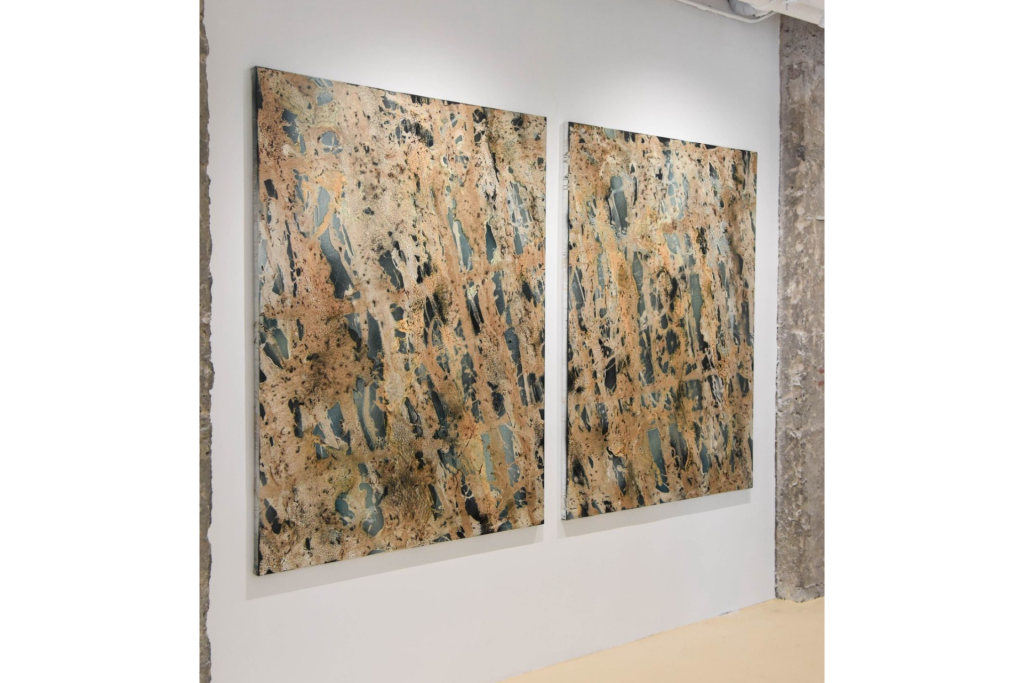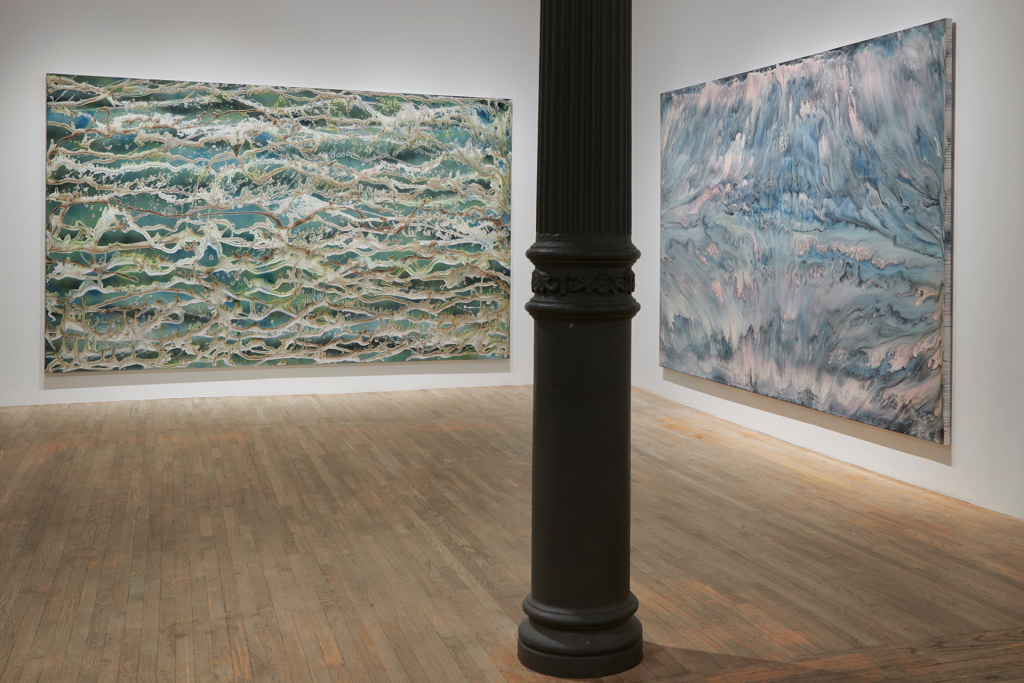The grandiose canvases of Márta Kucsora have been an enrichment to the MNB collection since 2017. With her abstract works the painter also emerges as a transformative force in Chinese contemporary art, as her recent works are on display at the Deji Art Museum and Shanghai’s Cobra Gallery. Kucsora, as co-founder of the Budapest Art Factory (BAF), is a pioneer, setting a new direction in the international waters of art creation and cultural organisation.
How did you get in touch with a Chinese gallery?
This is a very contemporary story; Cobra Gallery found me on Instagram. The internet opens a special door for those who create on the periphery of the art world, but at the same time have talent. I started working with Cobra a year and a half ago, and I have already participated in a duo and a group exhibition in Shanghai. I experienced that the way things happen there is just like anywhere else in the world. In 2023, my work was selected for Art 21 Shanghai Contemporary and the West Bund Art Fair. We have developed an extremely productive relationship and I am proud to say that we are in a successful collaboration.
When you work with a Chinese gallery, how do you work together, do any cultural differences come up?
Cultural differences can cause really complex problems, especially at the level of individuals. But I am convinced that my works have been able to bridge these linguistic and cultural gaps. The millennia-old, predominantly figurative Chinese visual culture meets my experimental and fundamentally abstract practice, which could bring a seismic shift to the Chinese contemporary art scene. My work is also sought after by designers and magazines, perhaps because its organic nature is in harmony with the freshness of contemporary China.
Works by Márta Kucsora at Cobra Gallery, Shanghai, 2024
Have you been to China?
I just came back from China a few days ago. I was in Shanghai for two exhibitions, a group exhibition that opened in the spring at CoBrA Gallery, and last week we opened a larger group exhibition in the museum-like exhibition space of several hundred square meters at the Amanyangyun Hotel. I arrived at the invitation of the owner of Aman Shanghai and gave a performance before the opening. During the trip, I visited the DEJI Art Museum in Nanking for the first time, where I met the director and discussed the details of my next exhibition. I also had several meetings in Beijing, for example at 798 Art Zone, which is located in Beijing’s most famous gallery district. Another solo exhibition is being planned there for 2025. I met Huang Rui, China’s best-known artist, and founder of 798 Art Zone, who is also included in both group exhibitions, which is an honour for me.
2023 was a busy and productive year for you, where have your pictures been to?
My work was shown at Postmasters Gallery in Rome in February, and from April to June at Galerie Melbye-Konan in Hamburg, where we have chosen a special selection of large-scale works. Of course, I didn’t miss out on exhibitions at home either, my lesser-known video work was shown at the BINÁLÉ digital art biennial in Budapest, as part of the Spring Festival, and I had a solo exhibition curated by Márton Orosz at the Kepes Institute. A related book is also about to be published. However, this forced march did not only affect me regarding my canvases, but also in reality, as I managed the moving of the Budapest Art Factory. The renewal of the Art Factory, though painstaking, has now created a platform that is a fitting home for the latest digital artists. We opened with the exhibition titled Distortions curated by Tamás Banovich/Postmasters and the programme will showcase the exhibitions of promising international galleries and curators. Professional cooperation with international institutions is a priority, while building cross-border connections.
Works by Márta Kucsora at Kepes Institute, 2023
Photo: Dávid Bíró
You seem to be a conscious artist who, in addition to your creative work, also takes time to blend in. When did it become clear to you that the theoretical anchor is also necessary?
After graduating from the University of Fine Arts, I won a scholarship to the United States. There, seven permanent theorists, artistic directors and curators worked with 22 artists, while a further 50 professionals were invited to give lectures or studio visits. This was 18 years ago, but during my time there I learned that it is essential to talk about my work, especially in order to be successful on the international stage. Today’s visual arts scene is much more about communication than pure creation. When I am creating, I become deeply immersed in my own world, so it is difficult to put the process into a structured form later, for example for a presentation. So, I need professionals who look at my work from the point of view of how it fits into contemporary art trends, drawing analogies, pointing out literary or scientific connections.
Márta Kucsora’s studio in the Artist Factory
The MNB collection purchased nearly twenty of your works in 2019, at the beginning of building the collection. How would you place these works in your oeuvre?
The works of 2017-18-19 were created in an era of experimental abstraction. These are large works, most of them 2×4 metres, some 2×2 metres and a few of these paintings are 120×120 centimetres. These are traces of intensive experiments in the use of materials, focusing on the same themes as today. These paintings usually fall into the category of effect-free painting, or what is known as gestural abstraction. Technically, it was during these years that I started to explore this new direction.
The temporal and spatial narratives inherent in my artworks are echoed in intentionally complex compositions that challenge conventional notions. I want to show the diversity of the creative process, where different inspirations merge into a single visual language; the online and offline experience of reality, family and exploring the international art world. My unique perspective that my paintings are „unfinished” allows for constant renewal, contributing to a non-linear narrative in the already fraught history of painting.
Márta Kucsora’s studio in the Artist Factory
Have these years brought with them an increase in size?
Yes, and it can be said that these iconic first works were the ones making it into the collection, where there was a big shift and I went completely in the direction of abstract.
Motherhood and the resulting confidence and calm led to a change of scale and step in painting; I finally dared to think and create big. This is also when performativity emerges as a method of painting, where paintings are able to evoke the microscopic and macroscopic universes of nature through the interaction of movement, action and interaction with materials.
Works by Márta Kucsora at In Postmasters Gallery, New York, 2021
Photo: Kyle Knodell
These works are therefore key, the first steps in new stages of your artistic development. This period is also reflected abroad. So, were these the first confident steps in the new period?
Absolutely. Five of my 2×4 metre works from 2015 have been included in the collection, which is fantastic because this is a size that private collectors don’t usually take on, they tend to be for institutions. It was at this time that I started to use the spray gun intensively in my painting, and to incorporate plants, for example. I started experimenting with plant prints after Moholy-Nagy’s photographic prints, which I then called plantagram. Moholy-Nagy also sought to transfer photographic technique into the field of painting.
These large-scale works from 2015 are also very important, milestones and fond memories because they are the first works of art created after the birth of my daughter. Having a child has brought major changes in my life, it has changed my approach to life and womanhood – and these changes are simply visible in my pictures. I used to create very dark works, almost black and white, but after giving birth my colour palette changed and many other factors influenced my creative process. It was a great liberation for me, and these works were decisive during this period. I am glad they are in good hands, part of a national collection where they are looked after. Should they ever be needed – for a retrospective exhibition, for example – they will be easily available. This is a very significant and culture-shaping collection.












